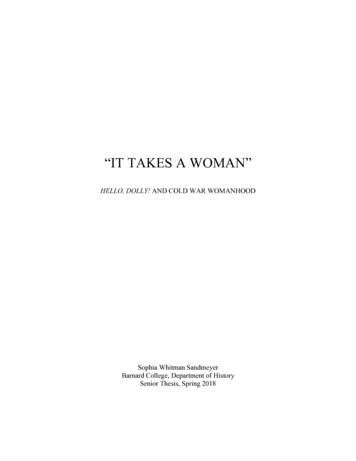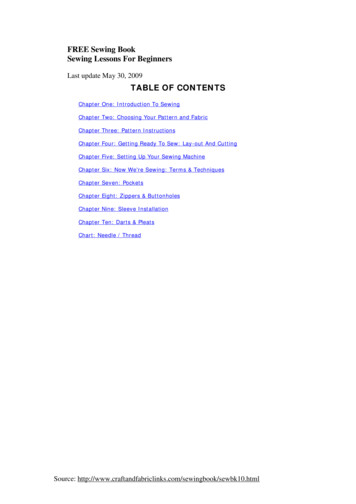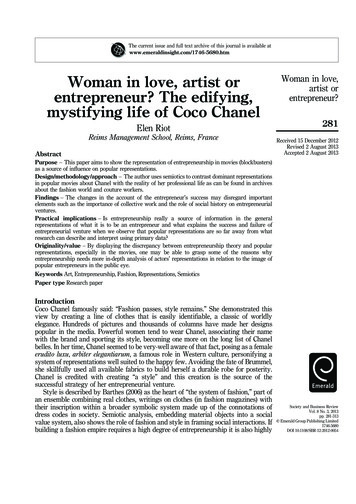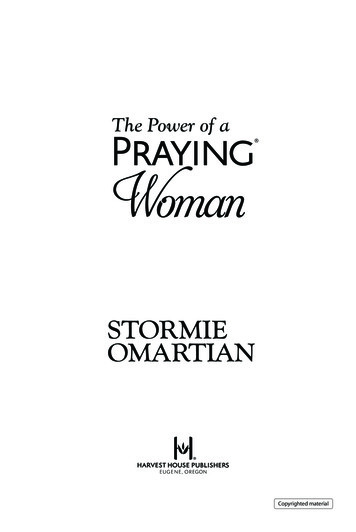
Transcription
“IT TAKES A WOMAN”HELLO, DOLLY! AND COLD WAR WOMANHOODSophia Whitman SandmeyerBarnard College, Department of HistorySenior Thesis, Spring 2018
“Yes it takes a womanA dainty womanA sweetheart, a mistress, a wifeO yes it takes a womanA fragile womanTo bring you the sweet things in life ”— “It Takes A Woman,” Hello, Dolly!
TABLE OF CONTENTSIntroduction . . . . . . . . . . . . . . . . . . . . . . . . . . . . . . . . . . . . . . . . . . . . . . . . . . . . . . . . . . . . . . . . . . 1CHAPTER ONE . . . . . . . . . . . . . . . . . . . . . . . . . . . . . . . . . . . . . . . . . . . . . . . . . . . . . . . . . . . . . . 8“Where You Belong”: Hello, Dolly! and Popular Constructions of American WomanhoodCHAPTER TWO . . . . . . . . . . . . . . . . . . . . . . . . . . . . . . . . . . . . . . . . . . . . . . . . . . . . . . . . . . . . 23“Motherhood, America, and a Hot Lunch for Orphans”: Traditional Gender Ideals and Cold WarPatriotismCHAPTER THREE . . . . . . . . . . . . . . . . . . . . . . . . . . . . . . . . . . . . . . . . . . . . . . . . . . . . . . . . . . 31Dolly Goes to War: Hello, Dolly!, Donut Dollies, and the Female Performance of PatriotismConclusion . . . . . . . . . . . . . . . . . . . . . . . . . . . . . . . . . . . . . . . . . . . . . . . . . . . . . . . . . . . . . . . . . 46Bibliography . . . . . . . . . . . . . . . . . . . . . . . . . . . . . . . . . . . . . . . . . . . . . . . . . . . . . . . . . . . . . . . . 49
INTRODUCTIONIt takes a certain kind of woman to don a headdress of towering red feathers, pair it with achoker dripping with diamonds, and complete the look with a sensational off-the-shoulder reddress. As this woman emerges through red velvet curtains and sashays down a red velvetstaircase to the enamored smiles of an entire restaurant, it is so clear that she is right where shebelongs—center stage, warmly meeting the gaze of the hundreds of eyes upon her. She isconfident. She is glamorous. She is spunky. She has agency. In the two-hour musical spectacle ofHello, Dolly!, the title character brings life, chaos, excitement, and love to her every interaction.Dolly Gallagher Levi is exactly the hilarious, fabulous diva the audience is expecting.She is imbued with the glamour and gumption of the leading ladies who play her. As onereviewer put it, Carol Channing, “with hair like orange sea foam, a contralto like a horse'sneighing,” brought the “confidential swagger of a blowsy showgirl” to her Dolly.1 Mary Martinbrought whimsy and compassion to hers.2 Most of all, every incarnation of Dolly Levi brought tolife the fiercely charming, mischievous, self-reliant woman penned by Jerry Herman.3She is the kind of woman who gets everything she wants and gives more. She is the kindof woman to know when to abandon a goal, especially when it causes more trouble than it isworth. Especially when this goal is a man. She is the kind of woman to take it upon herself to aska man to dinner. And to tell him to propose to her. But she is not the type of woman to grovel orbeg or pine. She is the kind of woman to sing “so long, dearie,” if he turns down her advances1Steven Suskin, Opening Night on Broadway: A Critical Quotebook of the Golden Era of the Musical Theatre,(New York: Schirmer Books, 1990), 297–301.2Richard Skipper, “Call on Dolly,” http://www.callondolly.com/mary-martin/.3Jerry Herman, Hello, Dolly!, (Washington, DC: DBS Publications, Inc., 1964). Hello, Dolly! is a musicaladaptation of the 1954 play The Matchmaker written by Thornton Wilder, a rewrite of his earlier play, The Merchantof Yonkers, written in 1938.1
one too many times.4 If a man ever dares to treat her “rotten and rough,” she’ll give him a waveand march away to bigger and better things.5And yet, when it comes down to it, she marries that man. Her calling in life is to makematches and the musical chronicles the most important match of her life: her own. Meremoments after sweeping onstage for the opening number, Dolly announces that she intends tomarry Mr. Horace Vandergelder. By the end of the song, the audience is fully confident of herability to do just that. By the end of the show, she has done it. Not only has she procured a ring,but she has also gotten Mr. Vandergelder to fall in love with her. He falls for all of her—herwhole confident, mischievous, spunky, decadent self. This intrepid, bedazzled heroine explainspartway through the show that she sees her unmarried self as “without color and without life.”6Once engaged to Horace, Dolly loses none of herself, only gaining a little color and a little life.As a representation of the ideal American women, Dolly Levi is hard to pin down. Is shethe ideal feminist woman—using her agency to shape her circumstances? Is she an affirmation oftraditional feminine domesticity? Is she both?Hello, Dolly! opened on Broadway in early January of 1964. Four months after opening,the show won a record-breaking ten Tony Awards, sweeping every major and minor category.Propelled to popularity by Louis Armstrong’s recording of its title song earlier in the winter,Dolly! fever swept the nation. The cast album rose to number one on the Billboard pop charts a4Original Broadway Cast, “So Long, Dearie” in Hello, Dolly! - Original Broadway Cast Recording 1964,Masterworks Broadway, 1964, ly-original-broadway-castrecording-1964/.5Original Broadway Cast, “So Long, Dearie” in Hello, Dolly! - Original Broadway Cast Recording 1964.6Jerry Herman, Hello, Dolly!, (Washington, DC: DBS Publications, Inc., 1964) 63.2
month after the Tonys, eventually being named America’s top performing pop album of the year,outperforming even The Beatles on their world tour.7In the years before Dolly! was written, Americans were adjusting to post-war prosperityand relative stability. Hoping to finally secure “normalcy” uninterrupted by financial depression,Nazis, or atom bombs, Americans hurried to the altar and then straight on to the suburbs. Ratesof marriage went up and divorce rates went down in the years following the war.8 Unlike thegeneration before or after them, the post-war generation embraced marriage and homelife withunprecedented fervor.9 Home, to families of the 1950s, was supposed to be “a shelter and ahaven from the stresses of the world.”10 The threat of another—this time, atomic—war and thevivid memories of brutal post-war depression pushed Americans to favor security.11Communism served as the greatest perceived threat to post-war American security.Communism threatened the American way of life not only by threatening to upend Americaneconomic superiority but also by threatening the sanctity of American values. After crushing thethreat of fascism, Americans saw both the physical threat of the Soviet Union as well as theideological, economic threat of communism as their most intrepid foe. By the end of the SecondWorld War, American propagandists were presenting the American family as the embodiment ofdemocratic values—and the clear foil to “unhappy” and “unfulfilling” Soviet way of life.12The image of satisfied, well-supported American families drove both the defensive andoffensive American Cold War anti-communist doctrine. American propaganda promoted the idea7“Billboard 200 Albums of the Year: 1956 to Now,” Billboard, December 10, 2015, accessed April 10, board-200-albums-of-the-year-1956-to-now.8Elaine Tyler May, “Introduction,” in Homeward Bound: American Families in the Cold War Era, (New York:Basic Books, 1988).9Elaine Tyler May, Homeward Bound, 9.10Elaine Tyler May, Homeward Bound, 190. A 1950s housewife, Nora Grey, articulates this understanding of ColdWar era homelife for American families.11Elaine Tyler May, Homeward Bound, 13.12Laura A. Belmonte, “The Red Target is Your Home: Images of Gender and the Family,” in Selling the AmericanWay: US Propaganda and the Cold War, (Philadelphia, PA: University of Pennsylvania Press, 2008), 137.3
that “happy family life cannot exist in the communist scheme of things.”13 Normative genderroles and upstanding Christian family life were understood as bulwarks against “dictatorship andintolerance, mind slavery and statism”—in other words, all that came along with Communism.14This anti-communism necessitated the image of the happy, white, suburban, heterogeneousfamily. American Cold War politicians and cultural producers understood this. TV producers,magazine publishers, and advertising agencies popularized the image of heteronormative familialbliss which both acknowledged and promoted a gendered ideal.15 Politicians reinforced thisimage in pro-America propaganda to encourage support of American capitalist ideology thatboth fostered and allowed for this happy family.16 This cultural production and Cold Warpropaganda, intentionally and unintentionally, linked any kind of subversion from thisheteronormativity to communism. This ideological link propelled the acceptance and promotionof heteronormative lives.17Popular culture depictions of everyday Americans reflected this gendered conception ofideal post-war life. Icons of demure domesticity flourished in the Cold War period of the latefifties and early sixties. Popular television shows, like Leave it to Beaver and Father Knows Best,13Laura A. Belmonte, “The Red Target is Your Home: Images of Gender and the Family,” in Selling the AmericanWay, 146 and 139. Belmonte references both USIS propaganda posters and the USIA essay “Democracy Begins inthe Home.”14Jane Sherron De Hart, “Containment at Home: Gender, Sexuality, and National Identity in Cold War America,”in Rethinking Cold War Culture (Washington and London, Smithsonian Institution Press, 2010), 130. De Hartoutlines her analysis of cultural subversiveness in Cold War culture in light of the importance of cultural normativityto American national security.15To read more about popular culture Cold War era representations of gender—especially in television and music,see Susan J. Douglas’ Where the Girls Are, (New York: Three Rivers Press, 1994). For a more detailed analysis ofgendered constructions of identity in magazines and magazine advertisements, specifically, see Nancy A. Walker’sShaping Our Mothers’ World: American Women’s Magazines (Jackson, MI: University of Mississippi Press, 2000)and her corresponding anthology of primary source material, Women’s Magazines 1940-1960: Gender Roles and thePopular Press, (New York: Palgrave Macmillan, 1998).16Chapter five of Laura A. Belmonte’s Selling the American Way, “The Red Target is Your Home: Images ofGender and the Family,” brings to light many of the advertising initiatives of the United States Information Agency,outlining a clear adoption of traditional gender roles in propaganda rhetoric.17De Hart, “Containment at Home: Gender, Sexuality, and National Identity in Cold War America,” in RethinkingCold War Culture.4
centered around the homelife of white suburban families. The effortless domesticity of thehousewife character was an integral part to this idealized image.Many American women tried to emulate this idealized domestic bliss in their own homesand marriages. Women hoped that their husbands would regard them as Carol Sears’s husbandRobert Sears did her. Robert noted that “when I’m crabby, [Carol] can handle me nicely andsoon has me smiling.”18 While women strove to support their husband’s emotional well-being,they also kept the house and took care of their children. Nora Grey remembers her day-to-dayroutine including “children’s care, housework, repairs, leaf raking, snow shoveling, some lawnmowing, and making all our clothing.”19 Women strove to do all they could to maintain thequality of their marriages and homelife. Their workplace was the home, yet their work was neversupposed to look or feel like work. A well-functioning home and family was thought to beparamount to the happiness and success of Americans, and women were at the center of this.Underneath the weight of this idealized—and for the most part, unattainable—culturalheteronormative bliss, American people—especially women and minorities—grew more andmore discontented with the prevailing ideal. For women, homemaking and mothering was meantto be as effortless and satisfying as it was for June Cleaver. The popularity of Betty Friedan’sbook, The Feminine Mystique, suggests that by the mid-1960s, many women of the Cold War eraconsidered domesticity to be the opposite of effortless and satisfying. Elucidating the “problemthat had no name,” Friedan faulted what she saw as “oppressive” and contradictory domesticexpectations for women reinforced by the male-dominated society.20 In 1964, the same year that18May, in Homeward Bound: American Families in the Cold War Era, 183, drawing on the responses fromparticipants in the 1955 survey of homelife and marriage, the Kelly Longitudinal Study (KLS).19May, in Homeward Bound: American Families in the Cold War Era, 189, drawing on the responses fromparticipants in the 1955 survey of homelife and marriage, the Kelly Longitudinal Study (KLS).20Betty Friedan, The Feminine Mystique, (New York: W. W. Norton and Co., 1963).5
Dolly! was climbing the pop charts, The Feminine Mystique became the best-selling non-fictionbook of the year, selling over one million copies.Betty Friedan’s critique helped to revitalized the feminist movement.21 Women likeGloria Steinem began picking up the cause of domestic oppression sparked by Friedan’s bookand upheld by her National Organization for Women. Married women began fighting in drovesfor the legal use of contraceptives and the right to work for equal pay outside of the home.22 Asthe gender revolution pushed on, women began calling for access to legal abortions andpromoting the passage of the Equal Rights Amendment.Soon these women would be creating popular media content of their own in magazineslike Ms, but until its founding in 1971, burgeoning feminists were seeking out feminist icons in
3 Jerry Herman, Hello, Dolly!, (Washington, DC: DBS Publications, Inc., 1964). Hello, Dolly! is a musical adaptation of the 1954 play The Matchmaker written by Thornton Wilder, a rewrite of his earlier play, The Merchant of Yonkers, written in 1938.











